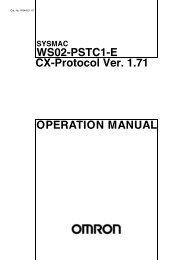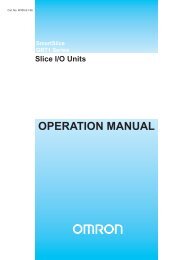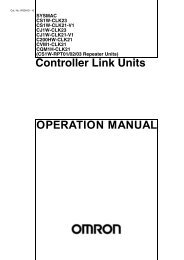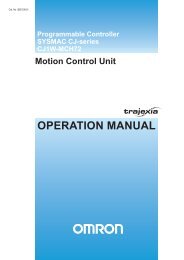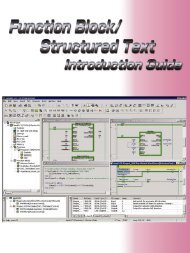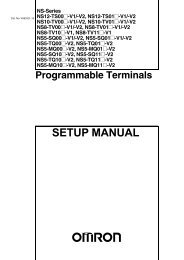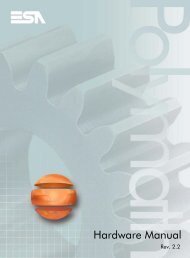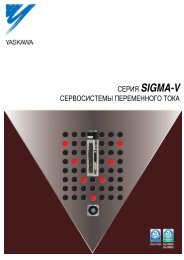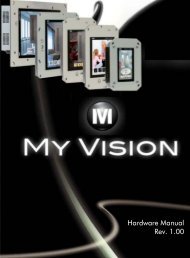- Page 1 and 2:
Cat. No. W266-E1-09 C200HW-SRM21-V1
- Page 4:
Notice: OMRON products are manufact
- Page 7 and 8:
viii TABLE OF CONTENTS SECTION 5 Sl
- Page 9 and 10:
x Product Name Series Manual Name C
- Page 11 and 12:
Application Considerations xii SUIT
- Page 14 and 15:
PRECAUTIONS This section provides g
- Page 16 and 17:
Operating Environment Precautions 4
- Page 18 and 19:
Application Precautions 5 Pay caref
- Page 20:
Conformance to EC Directives 6 6 Co
- Page 23 and 24:
System Overview and Features Sectio
- Page 25 and 26:
System Overview and Features Sectio
- Page 27 and 28:
CompoBus/S System Configuration Sec
- Page 29 and 30:
CompoBus/S System Configuration Sec
- Page 31 and 32:
Compatible Devices Section 1-3 Cabl
- Page 33 and 34:
Compatible Devices Section 1-3 Term
- Page 35 and 36:
Compatible Devices Section 1-3 14 a
- Page 37 and 38:
Compatible Devices Section 1-3 16 T
- Page 39 and 40:
Compatible Devices Section 1-3 18 C
- Page 41 and 42:
Startup Procedure Section 1-4 Conne
- Page 44 and 45:
SECTION 2 CompoBus/S System Specifi
- Page 46 and 47:
System Configuration Section 2-2 I/
- Page 48 and 49:
System Configuration Section 2-2 Sl
- Page 50 and 51:
System Configuration Section 2-2 Sl
- Page 52 and 53:
Supplying Power to the Slaves Secti
- Page 54 and 55:
Supplying Power to the Slaves Secti
- Page 56 and 57:
Supplying Power to the Slaves Secti
- Page 58 and 59:
Supplying Power to the Slaves Secti
- Page 60 and 61:
Supplying Power to the Slaves Secti
- Page 62 and 63:
System Configuration Using Water-re
- Page 64 and 65:
I/O Response Time Characteristics S
- Page 66 and 67:
I/O Response Time Characteristics S
- Page 68 and 69:
I/O Response Time Characteristics S
- Page 70 and 71:
I/O Response Time Characteristics S
- Page 72 and 73:
I/O Response Time Characteristics S
- Page 74 and 75:
SECTION 3 CompoBus/S System Wiring
- Page 76 and 77:
Connector Installation (Special Fla
- Page 78 and 79: Connector Installation (Special Fla
- Page 80 and 81: Connector Installation (Special Fla
- Page 82 and 83: Connector Installation (Special Fla
- Page 84 and 85: Connector Installation (Special Fla
- Page 86 and 87: VCTF Cable Assembly Section 3-3 Bra
- Page 88 and 89: Master/Slave Connecting Cables Sect
- Page 90 and 91: Master/Slave Connecting Cables Sect
- Page 92 and 93: Operations Checklist Section 3-5 CS
- Page 94 and 95: SECTION 4 Master Unit Specification
- Page 96 and 97: C200HW-SRM21-V1 Master Unit for CS-
- Page 98 and 99: C200HW-SRM21-V1 Master Unit for CS-
- Page 100 and 101: C200HW-SRM21-V1 Master Unit for CS-
- Page 102 and 103: C200HW-SRM21-V1 Master Unit for CS-
- Page 104 and 105: C200HW-SRM21-V1 Master Unit for CS-
- Page 106 and 107: C200HW-SRM21-V1 Master Unit for CS-
- Page 108 and 109: C200HW-SRM21-V1 Master Unit for CS-
- Page 110 and 111: CS1W-SRM21 Master Unit for CS-serie
- Page 112 and 113: CS1W-SRM21 Master Unit for CS-serie
- Page 114 and 115: CS1W-SRM21 Master Unit for CS-serie
- Page 116 and 117: CS1W-SRM21 Master Unit for CS-serie
- Page 118 and 119: CS1W-SRM21 Master Unit for CS-serie
- Page 120 and 121: CS1W-SRM21 Master Unit for CS-serie
- Page 122 and 123: CS1W-SRM21 Master Unit for CS-serie
- Page 124 and 125: CS1W-SRM21 Master Unit for CS-serie
- Page 126 and 127: CJ1W-SRM21 Master Unit for CJ-serie
- Page 130 and 131: CJ1W-SRM21 Master Unit for CJ-serie
- Page 132 and 133: CJ1W-SRM21 Master Unit for CJ-serie
- Page 134 and 135: CJ1W-SRM21 Master Unit for CJ-serie
- Page 136 and 137: CJ1W-SRM21 Master Unit for CJ-serie
- Page 138 and 139: CJ1W-SRM21 Master Unit for CJ-serie
- Page 140 and 141: CJ1W-SRM21 Master Unit for CJ-serie
- Page 142 and 143: CJ1W-SRM21 Master Unit for CJ-serie
- Page 144 and 145: CJ1W-SRM21 Master Unit for CJ-serie
- Page 146 and 147: CJ1W-SRM21 Master Unit for CJ-serie
- Page 148 and 149: CQM1-SRM21-V1 Master Unit for CQM1
- Page 150 and 151: CQM1-SRM21-V1 Master Unit for CQM1
- Page 152 and 153: CQM1-SRM21-V1 Master Unit for CQM1
- Page 154 and 155: CQM1-SRM21-V1 Master Unit for CQM1
- Page 156 and 157: CQM1-SRM21-V1 Master Unit for CQM1
- Page 158 and 159: SRM1-C0@-V2 Master Control Units Se
- Page 160 and 161: SRM1-C0@-V2 Master Control Units Se
- Page 162 and 163: CPM2C-S Series CPM2C-S@@@C (-DRT) S
- Page 164 and 165: CPM2C-S Series CPM2C-S@@@C (-DRT) S
- Page 166 and 167: SECTION 5 Slave Specifications and
- Page 168 and 169: Remote Terminals Section 5-1 5-1 Re
- Page 170 and 171: Remote Terminals Section 5-1 Indica
- Page 172 and 173: Remote Terminals Section 5-1 The fo
- Page 174 and 175: Remote Terminals Section 5-1 The fo
- Page 176 and 177: Remote Terminals Section 5-1 CompoB
- Page 178 and 179:
Remote Terminals Section 5-1 5-1-2
- Page 180 and 181:
Remote Terminals Section 5-1 Indica
- Page 182 and 183:
Remote Terminals Section 5-1 CompoB
- Page 184 and 185:
Remote Terminals Section 5-1 5-1-3
- Page 186 and 187:
Remote Terminals Section 5-1 Indica
- Page 188 and 189:
Remote Terminals Section 5-1 The fo
- Page 190 and 191:
Remote Terminals Section 5-1 Termin
- Page 192 and 193:
Remote Terminals Section 5-1 CompoB
- Page 194 and 195:
Remote Terminals Section 5-1 5-1-4
- Page 196 and 197:
Remote Terminals Section 5-1 Indica
- Page 198 and 199:
Remote Terminals Section 5-1 Termin
- Page 200 and 201:
Remote Terminals Section 5-1 5-1-5
- Page 202 and 203:
Remote Terminals Section 5-1 Slave
- Page 204 and 205:
Remote Terminals Section 5-1 Termin
- Page 206 and 207:
Remote Terminals Section 5-1 SRT@-M
- Page 208 and 209:
Remote Terminals Section 5-1 Relay
- Page 210 and 211:
Remote Terminals Section 5-1 Indica
- Page 212 and 213:
Remote Terminals Section 5-1 BS+ BS
- Page 214 and 215:
Remote Terminals Section 5-1 SRT@-R
- Page 216 and 217:
Connector Terminals Section 5-2 Ite
- Page 218 and 219:
Connector Terminals Section 5-2 Sla
- Page 220 and 221:
Connector Terminals Section 5-2 Nod
- Page 222 and 223:
Connector Terminals Section 5-2 The
- Page 224 and 225:
Connector Terminals Section 5-2 Rei
- Page 226 and 227:
Connector Terminals Section 5-2 Is
- Page 228 and 229:
Connector Terminals Section 5-2 Dim
- Page 230 and 231:
Connector Terminals Section 5-2 c.
- Page 232 and 233:
Connector Terminals Section 5-2 Mou
- Page 234 and 235:
Connector Terminals Section 5-2 5-2
- Page 236 and 237:
Connector Terminals Section 5-2 Sla
- Page 238 and 239:
Connector Terminals Section 5-2 Nod
- Page 240 and 241:
Connector Terminals Section 5-2 The
- Page 242 and 243:
Connector Terminals Section 5-2 Rei
- Page 244 and 245:
Connector Terminals Section 5-2 Is
- Page 246 and 247:
Connector Terminals Section 5-2 Dim
- Page 248 and 249:
Connector Terminals Section 5-2 a.
- Page 250 and 251:
Connector Terminals Section 5-2 Int
- Page 252 and 253:
Connector Terminals Section 5-2 MIL
- Page 254 and 255:
Connector Terminals Section 5-2 Com
- Page 256 and 257:
Connector Terminals Section 5-2 Mou
- Page 258 and 259:
Connector Terminals Section 5-2 Out
- Page 260 and 261:
Connector Terminals Section 5-2 Nod
- Page 262 and 263:
Connector Terminals Section 5-2 Wir
- Page 264 and 265:
Connector Terminals Section 5-2 Ter
- Page 266 and 267:
Connector Terminals Section 5-2 Dim
- Page 268 and 269:
Connector Terminals Section 5-2 Inp
- Page 270 and 271:
Connector Terminals Section 5-2 Ind
- Page 272 and 273:
Connector Terminals Section 5-2 Wir
- Page 274 and 275:
Connector Terminals Section 5-2 Ter
- Page 276 and 277:
Connector Terminals Section 5-2 Dim
- Page 278 and 279:
Connector Terminals Section 5-2 3.
- Page 280 and 281:
Connector Terminals Section 5-2 fir
- Page 282 and 283:
Remote I/O Modules Section 5-3 Outp
- Page 284 and 285:
Remote I/O Modules Section 5-3 2. T
- Page 286 and 287:
Remote I/O Modules Section 5-3 Prec
- Page 288 and 289:
Remote I/O Modules Section 5-3 BD L
- Page 290 and 291:
Water-resistant Terminals Section 5
- Page 292 and 293:
Water-resistant Terminals Section 5
- Page 294 and 295:
Water-resistant Terminals Section 5
- Page 296 and 297:
Water-resistant Terminals Section 5
- Page 298 and 299:
Water-resistant Terminals Section 5
- Page 300 and 301:
Water-resistant Terminals Section 5
- Page 302 and 303:
Water-resistant Terminals Section 5
- Page 304 and 305:
Water-resistant Terminals Section 5
- Page 306 and 307:
Water-resistant Terminals Section 5
- Page 308 and 309:
Sensor Terminals Section 5-5 5-5 Se
- Page 310 and 311:
Sensor Terminals Section 5-5 Slave
- Page 312 and 313:
Sensor Terminals Section 5-5 Hold/C
- Page 314 and 315:
Sensor Terminals Section 5-5 The fo
- Page 316 and 317:
Sensor Terminals Section 5-5 5-5-2
- Page 318 and 319:
Sensor Terminals Section 5-5 DIP Sw
- Page 320 and 321:
Sensor Terminals Section 5-5 Intern
- Page 322 and 323:
Fiber Amplifier Communications Unit
- Page 324 and 325:
Fiber Amplifier Communications Unit
- Page 326 and 327:
Fiber Amplifier Communications Unit
- Page 328 and 329:
Fiber Amplifier Communications Unit
- Page 330 and 331:
Analog Input Terminals Section 5-7
- Page 332 and 333:
Analog Input Terminals Section 5-7
- Page 334 and 335:
Analog Input Terminals Section 5-7
- Page 336 and 337:
Analog Input Terminals Section 5-7
- Page 338 and 339:
Analog Input Terminals Section 5-7
- Page 340 and 341:
Analog Output Terminals Section 5-8
- Page 342 and 343:
Analog Output Terminals Section 5-8
- Page 344 and 345:
Analog Output Terminals Section 5-8
- Page 346 and 347:
Analog Output Terminals Section 5-8
- Page 348 and 349:
I/O Link Units for CPM1A and CPM2A
- Page 350 and 351:
I/O Link Units for CPM1A and CPM2A
- Page 352 and 353:
I/O Link Units for CPM2C Section 5-
- Page 354 and 355:
I/O Link Units for CPM2C Section 5-
- Page 356 and 357:
Sensor Amplifier Terminals Section
- Page 358 and 359:
Sensor Amplifier Terminals Section
- Page 360 and 361:
Sensor Amplifier Terminals Section
- Page 362 and 363:
Sensor Amplifier Terminals Section
- Page 364 and 365:
Sensor Amplifier Terminals Section
- Page 366 and 367:
Sensor Amplifier Terminals Section
- Page 368 and 369:
Sensor Amplifier Terminals Section
- Page 370 and 371:
Sensor Amplifier Terminals Section
- Page 372:
Application Precautions Section 5-1
- Page 375 and 376:
Turning the Power ON Section 6-1 6-
- Page 377 and 378:
Checking Operations for CS-series,
- Page 379 and 380:
Checking Operations for CS-series,
- Page 381 and 382:
Checking Operations for CS-series,
- Page 383 and 384:
Checking Operations for CS-series,
- Page 385 and 386:
Checking Operations for CS-series,
- Page 387 and 388:
Checking Operations of CS-series an
- Page 389 and 390:
Checking Operations of CS-series an
- Page 391 and 392:
Checking Operations of CS-series an
- Page 393 and 394:
Checking Operations of CS-series an
- Page 395 and 396:
Checking Operations of CS-series an
- Page 397 and 398:
Checking Operations of CS-series an
- Page 399 and 400:
Checking Operations of CQM1 Master
- Page 401 and 402:
Checking Operations of CQM1 Master
- Page 403 and 404:
Checking Slave Operations Section 6
- Page 405 and 406:
Cleaning and Inspection Section 6-6
- Page 407 and 408:
Precautions for Replacement of Unit
- Page 409 and 410:
Standard Models Appendix Compatible
- Page 411 and 412:
Standard Models Appendix Water-resi
- Page 413 and 414:
Standard Models Appendix Connectors
- Page 415 and 416:
Standard Models Appendix MIL-compat
- Page 417 and 418:
396 DIP switch, 249 indicators, 249
- Page 419 and 420:
398 Analog Input Terminals, 16, 389
- Page 421 and 422:
400 Terminal-block Terminator speci
- Page 423 and 424:
402 Revision History Revision code
- Page 425:
Authorized Distributor: Cat. No. W2




